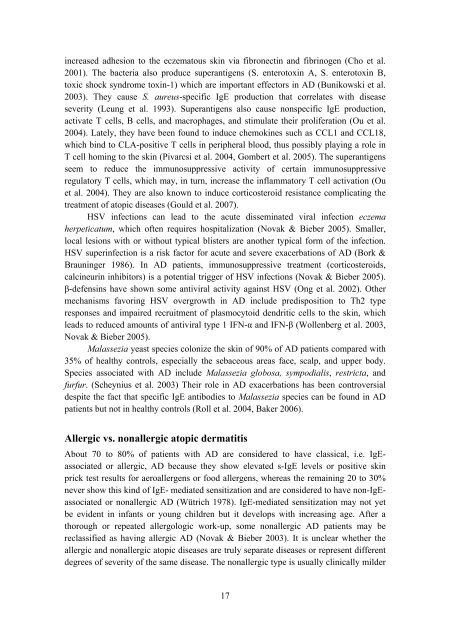Topical tacrolimus in atopic dermatitis: Effects of ... - Helda - Helsinki.fi
Topical tacrolimus in atopic dermatitis: Effects of ... - Helda - Helsinki.fi
Topical tacrolimus in atopic dermatitis: Effects of ... - Helda - Helsinki.fi
You also want an ePaper? Increase the reach of your titles
YUMPU automatically turns print PDFs into web optimized ePapers that Google loves.
<strong>in</strong>creased adhesion to the eczematous sk<strong>in</strong> via <strong>fi</strong>bronect<strong>in</strong> and <strong>fi</strong>br<strong>in</strong>ogen (Cho et al.<br />
2001). The bacteria also produce superantigens (S. enterotox<strong>in</strong> A, S. enterotox<strong>in</strong> B,<br />
toxic shock syndrome tox<strong>in</strong>-1) which are important effectors <strong>in</strong> AD (Bunikowski et al.<br />
2003). They cause S. aureus-speci<strong>fi</strong>c IgE production that correlates with disease<br />
severity (Leung et al. 1993). Superantigens also cause nonspeci<strong>fi</strong>c IgE production,<br />
activate T cells, B cells, and macrophages, and stimulate their proliferation (Ou et al.<br />
2004). Lately, they have been found to <strong>in</strong>duce chemok<strong>in</strong>es such as CCL1 and CCL18,<br />
which b<strong>in</strong>d to CLA-positive T cells <strong>in</strong> peripheral blood, thus possibly play<strong>in</strong>g a role <strong>in</strong><br />
T cell hom<strong>in</strong>g to the sk<strong>in</strong> (Pivarcsi et al. 2004, Gombert et al. 2005). The superantigens<br />
seem to reduce the immunosuppressive activity <strong>of</strong> certa<strong>in</strong> immunosuppressive<br />
regulatory T cells, which may, <strong>in</strong> turn, <strong>in</strong>crease the <strong>in</strong>flammatory T cell activation (Ou<br />
et al. 2004). They are also known to <strong>in</strong>duce corticosteroid resistance complicat<strong>in</strong>g the<br />
treatment <strong>of</strong> <strong>atopic</strong> diseases (Gould et al. 2007).<br />
HSV <strong>in</strong>fections can lead to the acute dissem<strong>in</strong>ated viral <strong>in</strong>fection eczema<br />
herpeticatum, which <strong>of</strong>ten requires hospitalization (Novak & Bieber 2005). Smaller,<br />
local lesions with or without typical blisters are another typical form <strong>of</strong> the <strong>in</strong>fection.<br />
HSV super<strong>in</strong>fection is a risk factor for acute and severe exacerbations <strong>of</strong> AD (Bork &<br />
Braun<strong>in</strong>ger 1986). In AD patients, immunosuppressive treatment (corticosteroids,<br />
calc<strong>in</strong>eur<strong>in</strong> <strong>in</strong>hibitors) is a potential trigger <strong>of</strong> HSV <strong>in</strong>fections (Novak & Bieber 2005).<br />
�-defens<strong>in</strong>s have shown some antiviral activity aga<strong>in</strong>st HSV (Ong et al. 2002). Other<br />
mechanisms favor<strong>in</strong>g HSV overgrowth <strong>in</strong> AD <strong>in</strong>clude predisposition to Th2 type<br />
responses and impaired recruitment <strong>of</strong> plasmocytoid dendritic cells to the sk<strong>in</strong>, which<br />
leads to reduced amounts <strong>of</strong> antiviral type 1 IFN-� and IFN-� (Wollenberg et al. 2003,<br />
Novak & Bieber 2005).<br />
Malassezia yeast species colonize the sk<strong>in</strong> <strong>of</strong> 90% <strong>of</strong> AD patients compared with<br />
35% <strong>of</strong> healthy controls, especially the sebaceous areas face, scalp, and upper body.<br />
Species associated with AD <strong>in</strong>clude Malassezia globosa, sympodialis, restricta, and<br />
furfur. (Scheynius et al. 2003) Their role <strong>in</strong> AD exacerbations has been controversial<br />
despite the fact that speci<strong>fi</strong>c IgE antibodies to Malassezia species can be found <strong>in</strong> AD<br />
patients but not <strong>in</strong> healthy controls (Roll et al. 2004, Baker 2006).<br />
Allergic vs. nonallergic <strong>atopic</strong> <strong>dermatitis</strong><br />
About 70 to 80% <strong>of</strong> patients with AD are considered to have classical, i.e. IgEassociated<br />
or allergic, AD because they show elevated s-IgE levels or positive sk<strong>in</strong><br />
prick test results for aeroallergens or food allergens, whereas the rema<strong>in</strong><strong>in</strong>g 20 to 30%<br />
never show this k<strong>in</strong>d <strong>of</strong> IgE- mediated sensitization and are considered to have non-IgEassociated<br />
or nonallergic AD (Wütrich 1978). IgE-mediated sensitization may not yet<br />
be evident <strong>in</strong> <strong>in</strong>fants or young children but it develops with <strong>in</strong>creas<strong>in</strong>g age. After a<br />
thorough or repeated allergologic work-up, some nonallergic AD patients may be<br />
reclassi<strong>fi</strong>ed as hav<strong>in</strong>g allergic AD (Novak & Bieber 2003). It is unclear whether the<br />
allergic and nonallergic <strong>atopic</strong> diseases are truly separate diseases or represent different<br />
degrees <strong>of</strong> severity <strong>of</strong> the same disease. The nonallergic type is usually cl<strong>in</strong>ically milder<br />
17

















